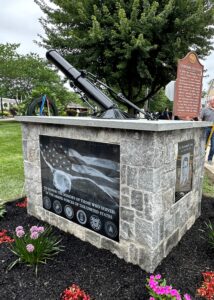Last week, we rededicated a historic monument to an American hero, Lieutenant
Raymond B. Jauss, a resident of Congers who was one of 116,708 American casualties
in the First World War. Raymond B. Jauss was born on September 12, 1894 in Albany,
New York; his proud parents were Harry and Lillian Jauss. Mr. Jauss was an engineer,
and at the time of his son’s death was Superintendent of the New York Central Railroad
Station at Weehawken, New Jersey.
The Jauss family had two residences, living primarily at 151 East 80 th Street in
Manhattan and maintaining a summer residence here in Congers. It was during these
summers in Congers that Raymond came to know Harriet James, who lived across the
street from him. A friendship developed that grew into a romance over time. Raymond
enrolled in college at Columbia University, where he graduated in 1916 with a degree in
Civil and Sanitary Engineering. After graduating, Raymond was working as a Sanitary
Engineer when the United States declared war on Germany and officially entered into
World War I in April of 1917.
On August 15, 1917 Raymond entered military service and was provisionally
commissioned as a 2 nd Lieutenant. He went for training and was successively assigned
to Camp Greene in North Carolina; then to Charlotte, North Carolina; and finally to
Plattsburg, New York, where he was provisionally promoted to 1st Lieutenant and
assigned to the 30 th Infantry Regiment of the 3 rd Division. It was here that he learned of
his imminent transfer overseas to serve in combat. Before leaving for war, Raymond
decided to return to Congers to quickly wed his childhood sweetheart, Harriet James.
Raymond sailed for Europe on April 1 st , 1918, a time of intense German action that was
threatening the allied hold on France. As Jauss arrived in Europe, Germany was
engaging in a series of large-scale offensive battles seeking to divide the British and
French forces. Germany had broken the Allied lines using the Marne River as the route
to take Paris with the hopes of forcing France to surrender and Britain to negotiate a
peace to end the war.
On midnight of July 14, 1918, the fighting commenced that was to become known as
the “Second Battle of the Marne.” It was during this decisive battle that the 3rd Division earned the distinction that would lead to its storied nickname, “The Rock of the Marne,”
as they were badly outnumbered and surrounded, yet held fast. The Battle was part of
the larger Aisne-Marne Offensive that saw the United States troops holding in position
against an overwhelming number of German forces and eventually pushing the
Germans back. In fact, the Commanding Officer of the Division Major General Joseph
Dickman, during the heat of this battle, famously cried out in French: “We Shall Remain
Here,” which became a rallying cry. The French units on his flank had fallen back, but
the doughboys stood firm. The Division did indeed remain in place and by the end of the
first day the Americans had withstood the assault.
During the next two days, a furious counter attack decimated several German units. In
the end, the badly outnumbered United States Forces fought and defeated six German
regiments from two German divisions. One German regiment, which had 1,700 soldiers,
was reduced to only 150 survivors. The engagement was the last serious German
offensive action of the war in France. According to the Commanding Officer of the
American Expeditionary Forces, General John “Black Jack” Pershing, the brave and
gallant actions of the 3 rd Division were “One of the most brilliant pages in the annals of
military history.”
According to numerous reports, Lt. Jauss was deep into this engagement and was
assigned to the intelligence section. He was checking on forward observation posts
when he was killed by an enemy shell sometime late on the first day or early on the
second day of battle. He was said to be carrying important communication dispatches to
the forward area, as communications had failed during the battle. Lt. Jauss was credited
with passing along information vital to the early success of the Allied troops. Eventually,
Lt. Jauss’ body was recovered and he was buried with full military honors at the
American Military Cemetery located at Belleau Aisne, France.
On August 9 th , 1918 by an act of Congress, President Wilson posthumously awarded Lt.
Raymond B. Jauss the Distinguished Service Cross, which is the second highest award
bestowed upon United States Military personnel. The French Government also honored
Jauss, bestowing the equally prestigious Crux de Guere.
After the war, the young widow Harriet Jauss became a teacher and eventually
remarried Edgar Jolliffe. According to her 1975 Journal News obituary, she had
remained a Congers resident for seventy years after moving here from New Jersey in
1905. She remained in Congers until her death in 1975. She was a local elementary
teacher for over fifty years and was a member of the Congers United Methodist Church,
located at the corner of Lake Road and Old Haverstraw Road. Reportedly, she died at
the old County hospital in Pomona after a period of illness.
The Congers monument dedicated to Jauss has an interesting history of its own. It is
tied to the creation of the first Veterans of Foreign War Post that was commissioned in
Congers, also in honor of Lt. Jauss, on May 24, 1936. The Journal News edition dated
May 25, 1936 offers a detailed explanation of the chartering of the new Congers VFW
Post with state and national veterans leaders in attendance. The original flag that
adorned the casket of Lt. Jauss in 1918 was presented to the VFW Post. The article
suggests the post was chartered after a parade to the school auditorium as an overflow
crowd listened to numerous speeches, including one from a soldier who fought in the
same battle in which Lt. Jauss was killed.
The Post eventually built the original monument at Congers Station Park, which in
recent years had deteriorated badly and was in need of restoration. Anyone who knows
Congers knows the significance of the monument affectionately called the ‘cannon’ by
local residents. Over the years it has been a source of pride and a focal point for
gatherings. We rededicated this iconic monument cognizant of the memory of sacrifice
that it commemorates. July 15, 1918, exactly 105 years ago, Lt. Raymond B. Jauss paid
the ultimate sacrifice. An accomplished person with so much to live for, he voluntarily
served, fought, and willingly gave his life for his country.
I hope you will take the time to visit the newly restored monument. Let it continue to be
a place of gathering, as people pause to reflect on the true cost of freedom. Let it be a
place of recommitment to high ideals and patriotic fervor. May it stand here for the next
one hundred years and be a solemn reminder that a hero once walked these quiet
country streets. Let this memorial be an everlasting reminder to all who pass by of the
terrible cost of freedom that we can never repay.




